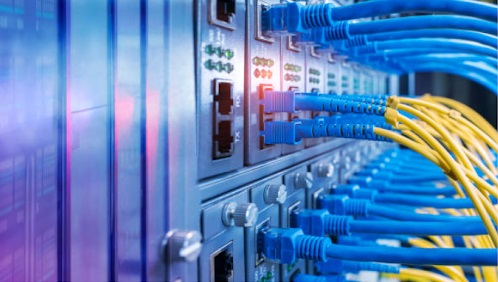Comparing Wireline vs. Wireless Infrastructure
Understanding Wireline vs. Wireless Infrastructure
Businesses rely on network infrastructure for communication, data transfer, and daily operations. Choosing between wireline and wireless infrastructure is a critical decision that affects performance, security, and cost. Wireline infrastructure uses physical connections, such as fiber-optic or Ethernet cables, to transmit data. On the other hand, wireless infrastructure relies on radio signals to connect devices without physical wires. Both options have advantages and limitations depending on business needs, industry requirements, and network demands.

Key Differences Between Wireline and Wireless Infrastructure
1. What Are the Performance Differences Between Wireline and Wireless?
Reliability is a key factor when comparing wireline vs. wireless infrastructure. Wireline networks provide stable connections with minimal interference, making them ideal for businesses that require high uptime and consistent performance. Fiber-optic and Ethernet cables offer strong signal integrity and reduced latency, ensuring reliable data transfer.
While offering greater flexibility, wireless networks can be affected by interference from physical obstructions, network congestion, and environmental factors. Wi-Fi and cellular connections may experience fluctuations in speed and connectivity, which can impact business operations. Organizations that rely on real-time data transmission, such as financial institutions or healthcare providers, often prefer wireline infrastructure for reliability.
2. Which Is More Cost-Effective: Wireline or Wireless Infrastructure?
Cost is a significant factor when evaluating wireline vs. wireless infrastructure. Wireline networks typically require higher initial investment due to equipment, installation, and maintenance costs. Businesses must budget for fiber-optic cabling, network switches, and physical infrastructure upgrades. However, wireline solutions often offer long-term cost efficiency due to their durability and lower susceptibility to interference or outages.
Wireless infrastructure generally has lower upfront costs, eliminating the need for extensive cabling. Businesses can deploy Wi-Fi access points or cellular-based solutions with minimal physical installation. However, ongoing costs such as bandwidth upgrades, network security enhancements, and potential performance limitations may impact overall expenses. Organizations must weigh these factors to determine the most cost-effective option.
3. Is a Wired or Wireless Network Better for Speed and Bandwidth?
Speed and bandwidth requirements vary depending on business operations. Wireline infrastructure, particularly fiber-optic networks, delivers high-speed data transmission with minimal latency. This makes it ideal for businesses that require large data transfers, video conferencing, or cloud computing services. Ethernet connections also provide stable bandwidth for corporate networks, ensuring consistent performance.
Wireless networks offer convenience and mobility but may experience speed fluctuations due to interference, congestion, or distance from access points. While modern Wi-Fi technologies, such as Wi-Fi 6, improve bandwidth capacity, they still rely on shared access, which can slow down performance during peak usage. Businesses with high data demands often prioritize wireline networks for consistent speed and bandwidth availability.
4. Are Wired or Wireless Networks More Secure?
Security is a significant concern in network infrastructure. Wireline connections are inherently more secure because they require physical access to intercept data transmissions. Businesses can implement firewall protections, encrypted connections, and network segmentation to enhance security in wired environments.
Wireless infrastructure, while convenient, presents additional security challenges. If not properly secured, Wi-Fi networks are vulnerable to unauthorized access, signal interception, and cyber threats. To mitigate risks, businesses must implement strong encryption, multi-factor authentication, and network monitoring. Organizations handling sensitive data, such as healthcare providers or financial institutions, often choose wireline solutions to enhance security and compliance.
Which Industries Benefit More from Wireline vs. Wireless?
Industries That Rely on Wireline Networks
Specific industries require stable, high-speed, secure connections that wireline infrastructure provides. These include:
- Financial institutions – Require secure, high-bandwidth connections for real-time transactions and encrypted communications.
- Healthcare providers – Depend on reliable data transmission for patient records, telemedicine, and medical imaging.
- Data centers – Need high-speed fiber-optic connections to manage large-scale data storage and processing.
- Manufacturing facilities – Utilize wired networks for automation, machine-to-machine communication, and operational stability.
Industries That Thrive on Wireless Networks
Other industries benefit from the flexibility and mobility that wireless infrastructure provides, including:
- Retail businesses: Use wireless networks for customer transactions, mobile point-of-sale systems, and inventory management.
- Logistics and transportation: Depend on wireless connectivity for fleet tracking, GPS navigation, and remote communications.
- Education and corporate offices: Enable flexible work environments, remote access, and collaboration through wireless networks.
- Hospitality and entertainment: Provide seamless internet access to guests and staff without requiring extensive cabling.
How DataField Helps Businesses Choose the Right Infrastructure
DataField Technology Services provides expert guidance in selecting the proper network infrastructure. Businesses can consult DataField to evaluate their operational needs, budget, and security requirements. Whether deploying a wireline or wireless network, DataField ensures seamless integration, optimal performance, and long-term scalability.


